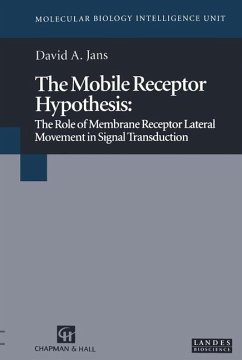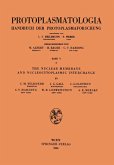1. Introduction to the Mobile Receptor Hypothesis.- A. The Fluid Mosaic Model of Biological Membranes.- B. The Mobile Receptor Hypothesis.- C. Modern Collision Coupling Theory.- D. Summary and Implications.- 2. Direct Measurement of Lateral Mobility.- A. Introduction.- B. Fluorescence Microscopy.- C. Confocal Microscopy.- D. Fluorescence Photobleaching Recovery.- E. Lateral Mobility in the Cytoplasm and Membranes of Living Cells.- F. Measurements in Artificial and Isolated Membranes.- G. Measurements of Lateral Mobility Using Other Methods.- H. Summary.- 3. Parameters Affecting Plasma Membrane Protein Lateral Mobility.- A. Mechanisms of Protein Immobilization in Biological Membranes.- B. Membrane Lipid Mobility.- C. The Cytoskeleton.- D. Anchorage Modulation.- E. Membrane Protein Sequence Motifs.- F. Domain Structure: Regions of Restricted Mobility.- G. Signal Transduction.- H. Summary.- 4. Lateral Mobility of Polypeptide Hormone Receptors and GTP-Binding Proteins.- A. Introduction.- B. Practical Considerations.- C. Lateral Mobility Measurements of Polypeptide Hormone Receptors.- D. Tyrosine Kinase Receptor-Mediated Signal Transduction.- E. GTP-Binding Protein Activating Receptor-Mediated Signal Transduction.- F. Structural Considerations.- G. Lateral Mobility Measurements of GTP-Binding Proteins.- H. Lateral Mobility of Cytokine Receptors.- I. Summary and Implications for Signal Transduction.- 5. Evidence for the Role of Membrane Receptor Lateral Movement in GTP-Binding Protein-Mediated Signal Transduction.- A. Introduction.- B. Kinetic Considerations in GTP-Binding Protein-Mediated Receptor-Effector Systems.- C. Indirect Evidence for a Role of Receptor Lateral Movement in GTP-Binding Protein-Mediated Signal Transduction.- D. Direct Evidence for a Role of Receptor Lateral Movement in GTP-Binding Protein-Mediated Signal Transduction.- E. Ga Signaling in the Cytosolic Phase.- F. Stoichiometric Considerations and Trimeric GTP-Binding Protein Immobility.- G. Amplification in GTP-Binding Protein-Mediated Receptor-Effector Systems Through Receptor Lateral Movement.- H. Summary.- 6. Evidence for the Role of Receptor Immobilization in Desensitization Subsequent to Hormonal Stimulation.- A. Introduction.- B. Receptor Internalization in Desensitization of Response.- C. Receptor Immobilization Prior to Internalization.- D. Receptor Movement Required for Internalization.- E. Kinetic Considerations with Respect to Lateral Mobility Measurements.- F. Receptor Phosphorylation.- G. Studies with Receptor Antagonists¿Receptor Immobilization Is Agonist-Dependent.- H. Summary.- 7. Evidence for the Role of Immobilization of Ligand-Occupied Membrane Receptors in Signal Transduction.- A. Introduction.- B. Receptor Immobilization in Tyrosine Kinase Receptor Signaling.- C. Receptor Immobilization in Signaling by Fc Receptors.- D. Receptor Immobilization in Cell-Cell Interaction.- E. Receptor Immobilization in Cell-Adhesion to an Extracellular Substratum.- F. Summary.- 8. The Mobile Receptor Hypothesis: A Global View.- A. Introduction.- B. Receptor Lateral Movement in Signal Transduction.- C. The Central Role of the Cytoskeleton.- D. Signal Transduction: Receptor Lateral Mobility Modulation by Heterologous Signaling.- E. Potential Pharmacological Applications of the Mobile Receptor Hypothesis.- F. Concluding Remarks.
Bitte wählen Sie Ihr Anliegen aus.
Rechnungen
Retourenschein anfordern
Bestellstatus
Storno









